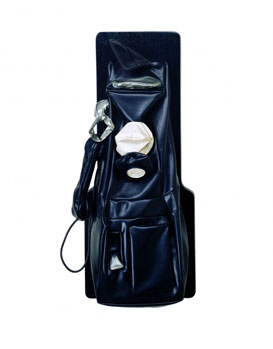
The Store and Home
Soft Pay-Telephone, 1963
Vinyl filled with kapok, mounted on painted wood panel
118.2 x 48.3 x 22.8 cm
Solomon R. Guggenheim Museum, New York, Gift Ruth and Philip Zierler in memory of their departed son, William S. Zierler 80.2747
“When you make art you want to put the human experience into it. I think the only thing that really saves the human experience is humor. I think without humor it wouldn’t be much fun.” —Claes Oldenburg (1)
Soon after presenting The Street, Claes Oldenburg began The Store in 1961. From the wider focus of the dilapidated urban street scene, Oldenburg zoomed in on the semiprivate space of the store. He rented a storefront in Manhattan in summer 1961 that he transformed into a space from which to make, display, and sell his objects.
Taking inspiration from advertisements and the other stores around him, Oldenburg made objects such as a cigarette pack, a pair of red tights, and two cheeseburgers out of muslin soaked in plaster, fitted over wire frame, and covered with bright, glossy, expressionistic paint strokes. The objects were of various sizes with irregular surfaces. They hung from the ceiling and walls, lay on the floor, or were set on display counters. Oldenburg constructed his own store sign, as well as a cash register, which he called the “cold heart” of the store. The objects took on anthropomorphic qualities. Two Cheeseburgers, with Everything (Dual Hamburgers) (1962) looked like two gaping, ravenous mouths. Two Girls’ Dresses (1961) conjured the image of two girls running. For his later, second version of The Store, he made soft sculptures in collaboration with his then-wife Patty Mucha, such as the outsized, stuffed-canvas Floor Cake and Floor Cone (both 1962).
The Store functioned as an important alternative to the traditional gallery space (later, his public monuments also played this role), inverted the capitalistic system, and erased the divide between high and low art, and between gallery and junk shop. His art pieces––with their simple materials, loud colors, and depiction of everyday objects––also did not look like typical museum objects. “The museum is a bourgeois institution,” Oldenburg said, “but the store stands beneath it—and is thus immune from becoming bourgeois.” (2)
In 1963, during a stay in California, Oldenburg set his focus on a more private sphere of objects when he began working on the theme of the Home (1963). The objects he made differed in construction and appearance from his objects in The Street and The Store. None were made in life-size scale, few were brightly colored, and many of them were covered in a glossy vinyl. This turned the ever-present, familiar objects of the home into strange, anthropomorphized objects with no functionality. The gigantic size of the objects, one version rendered in cardboard and another in colored fabric and glossy vinyl, dwarfed the viewers.
Soft Pay-Telephone (1963) is one of Oldenburg’s soft sculptures. Its gleaming vinyl surface is reminiscent of the hard industrial materials—such as metal and plastic—that a payphone is made of, but it droops and sags, rendering the thought of using it comical. Oldenburg often made multiple versions of his soft sculptures, calling those made of cardboard and wood the “hard version” and those made of canvas the “ghost version.” The materials of these versions relate to craft production whereas the vinyl of Soft Pay-Telephone undeniably references the industrial materials that were then becoming common in the production of housewares, which made for rapidly produced, inexpensive, and hygienic furnishings and production.
1. “Claes Oldenburg: The Sixties,” YouTube video, 2 min., 52 sec., posted by mumokvienna, March 14, 2012.
2. Jörg Wolfert, Claes Oldenburg: The Sixties exhibition brochure, translated by Cynthia Hall (Vienna: Museum Moderner Kunst Stiftung Ludwig Wien, 2012) p. 8
Preguntas
Look together at Soft Pay-Telephone. What do students notice about it? Encourage them to think about the materials, the scale, and the shape. Ask them to imagine using this object. What would happen if they did?
Ask students to compare Soft Pay-Telephone with a real telephone. What are the differences and similarities?
People say that many of Oldenburg’s sculptures are anthropomorphic, meaning they look like they have human characteristics. Do students see these characteristics in Soft Pay-Telephone? What kind of movement does it suggest?
This sculpture is from Oldenburg’s series Home, in which he constructed sculptures depicting many household items, including often-overlooked objects such as plugs. Ask students which object from their homes they would make into a sculpture, and why.
Oldenburg has said: “When you make art you want to put the human experience into it. I think the only thing that really saves the human experience is humor. I think without humor it wouldn’t be much fun.” What do students think about this quote and how it relates to this piece? Do they think Soft Pay-Telephone is funnier made of vinyl or made of canvas [Soft Pay-Telephone (Ghost Version), 1963.
